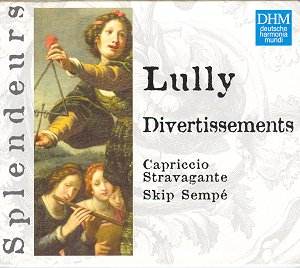Lullyís importance
in the history of French baroque is
well recognised, yet his music is relatively
unheard. Perhaps the genre of the pure
French style, in Lullyís time much less
influenced by Italy, has still to find
a wide listening public. That said,
the superficially more austere clavécinistes
like Louis Couperin and even díAnglebert
seem to figure more in concert and recordings.
Considering the vogue for Rameauís operas,
it is perhaps surprising that those
of Lully, the first major composer of
French opera, have not had more attention.
Skip Sempé has put together three
Divertissements from Lullyís chamber
music and airs, going back to original
sources in the absence of modern performing
editions. The music is in five parts
and Sempé, employs two violins,
a viola, a viola da gamba, a cello and
a harpsichord (he very reasonably argues
for mixing the violin and viol families).
Vocal items make up about a quarter
of the pieces and half the music on
the CD.
So the signs were good
and it is certainly true that Lullyís
music needs recording. However, listening
pleasure didnít measure up to the conception,
for several reasons. Firstly, although
the instrumentation looks good on paper
and Sempé makes a good case for
it, the sound was both top and bottom
heavy, i.e., there seemed to be a hole
in the middle. This impression may have
partly been due to the second problem,
the sourness of the violinsí sound which
was difficult to ignore. Thirdly, the
airs and recitatives, sung in Guillemette
Laurensís rich mezzo were almost wholly
melancholy. Of course, it seems crass
to expect otherwise when this is merely
a reflection of the taste of the age
but I could not help looking forward
to some instrumental jollity to dispel
the air of self-pity. Regrettably, the
sound of those violins soon put paid
to my relief. I also found the tempos
sluggish; the music could have danced
more.
If you are a wholly
committed Lullian, and you liked the
abrasion of baroque violins before the
modern players began to get a good sound
out of them, and you can bear to play
just a few numbers at a time, then you
might like this CD. My advice is, give
it a miss and buy Jordi Savallís compendium
of Suites on Alia Vox instead. Not chamber
music, it is true, but with its colourful
textures and vitality, a much better
introduction to Lullyís music.
Roger Blackburn


